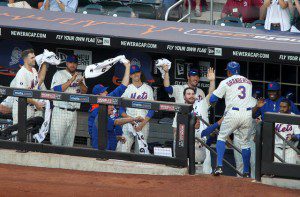
After an 8-2 homestand in which they went 6-1 against the Braves and Marlins, the New York Mets go into the All Star Break with as much mid-season hope as they’ve had in years. Their rotation continues to produce quality starts, and their bullpen has emerged as one of the National League’s strongest–but now they’re showing sings on offense, making them look like a more complete team. They’ve also begun to look like a team that’s taking control of its destiny.
Settling into their roles
As I’ve lamented before, earlier this season the Mets seemed prone to making poor decisions regarding their lineup. While they were deciding between Lucas Duda and Ike Davis as their first baseman of the future (choosing Duda was the beginning of their recent trend of wiser decision making), they never seemed to give either one a true chance to distinguish themselves. When they finally chose Duda, they seemed reluctant to let him get his bearings in the cleanup spot where he belonged. One bad day, one tough lefty, and Luke found himself batting seventh or on the bench. Not any more. Duda has been a daily fixture at cleanup recently, and he’s flourished there. Among the league leaders in hard-hit balls, Duda’s driving the ball to all fields; he continues to hit well with runners in scoring position, and he’s hitting more of the jaw-dropping blasts that remind us of his raw power.
Meanwhile, Curtis Granderson has established himself comfortably at the top of the order. Grandy’s middle-order seasons in the Yankees’ bandbox made it easy to forget that he put himself on the map, with the Detroit Tigers, as a leadoff hitter. Juan Lagares, since returning from the disabled list, is finally being put in run-producing spots in the lineup, where his speed, hustle and gap-to-gap hits can boost production.
With Granderson and Duda in positions that favor their strengths, Daniel Murphy and David Wright are flourishing as the Mets’ two best overall hitters. Wright seems more relaxed, and less prone to trying to do everything himself, as Murphy continues to rip the ball from the two-spot. At the bottom end of the order, Ruben Tejada continues to show renewed confidence, hitting line drives as the kind of 8th spot x-factor that makes a good offensive team even better. Last but not least, Travis d’Arnaud is hitting .273 since his brief trip back to the minors, producing good at-bats, line drives and occasional home run power. The Mets have climbed into the top half in the National League in offense, and lately it feels as if they’re never out of a game.
As the core lineup has settled, the Mets’ bench has emerged as a strength despite the unorthodox move of carrying six outfielders. Despite losing his spot atop the order, Eric Young Jr has continued to spark the team via his limited role. As a switch-hitting speed merchant who’s stolen 25 bases despite irregular playing time, EY has been valuable as a versatile spot-starter, pinch hitter and pinch runner. Even from the bench, he continues to bring his signature hustle and energy. With EY, Kirk Nieuwenhuis and others, the Mets’ bench now has speed, power, and strong defensive outfielders, as well as loads of energy and enthusiasm. It also has Bobby Abreu, a deceptively dangerous veteran who brings presence and experience but also seems to have picked up on the new youthful mojo.
New approach, new vibe
Another thing the Mets have fine-tuned is their approach. At one point this season, the as Mets led the National League in walks and strikeouts. As such, they often seemed to have men on base–and often seemed to leave them on base in clutch situations. Pitchers who pounded the strike zone often put them in unfavorable counts and had them off balance, forced to chase pitcher’s pitches instead of dictating the flow of the at-bat. Selectivity is an important part of hitting, but their approach was more passive than selective. Now, the Mets are more likely to swing at the first fastball. Or even on 3-0, a count in which Granderson has had much success of late. This makes them unpredictable, and puts more pressure on pitchers to execute under duress. No longer promised strike one, pitchers have begun to nibble around the edges of the strike zone. This still puts the Mets in favorable counts and leads to walks, but it also leads to more hung sliders as pitchers face greater uncertainty.
Hand in hand with their new assertive approach is the Mets’ growing aura of confidence and positivity. The Mets have recently begun punctuating big hits with enthusiastic towel waving in the dugout and the bullpen; there’s even a towel-tunnel gauntlet routine, where guys who hit home runs run through it and then back again before the requisite dugout congratulations.
Not there yet
The fact is, the Mets still have work to do. They’re still seven games out of first place, and they open the second half on the West Coast, where recent seasons have gone to die. But this starting to feel like a team that’s turning the corner and not looking back. Still pitching-oriented, they’re starting to show threat potential on offense; this means they can win different types of games and are hard to put away. Through assertiveness, togetherness, balance and enthusiasm, the Mets are changing their sense of themselves–and everyone else’s sense of them.
